Gold to Thrive in a Fiat Ponzi with Negative Yield
Commodities / Gold and Silver 2016 Aug 08, 2016 - 02:38 PM GMTBy: John_Lee
 Summary:
Summary:
- So if you are buying government bonds, expecting a decent return at the current puny level of yields, you are chasing the price. You are a speculator focusing on price, not yield. …If you are buying equities at current sky-high prices, you are chasing the yield. The mirror image of bonds.
- Gold bottomed in December 2015, after a much-anticipated Federal Reserve interest rate hike – the first in 7 years. Perhaps the market sensed that the Fed has done away with its interest hike campaign?
- Either way (hike or no hike), there is no place for the gold bull to hide. It took gold approximately 7 months to advance $250 and overcome major resistance at $1,300/oz from a bottom of $1,050. A reasonable target could be $1,550/oz ($1,300 + $250) by March 2017 – 7 months from now. Silver could follow a similar pattern with a near-term target of $26/oz.
I came across a very interesting article by David Rosenberg titled “Bonds are the new stocks and stocks are the new bonds”[1]in which, Mr. Rosenberg made several astute observations:
“…as the first of the boomers turn 70, [2016] was the year that for the first time ever, roughly $13 trillion of global government bonds slipped into a negative yield. Another $14.5 trillion reside between 0 per cent and 1 per cent. So consider that over three-quarters of the world’s sovereign bond market trades at 1 per cent or lower. Barely more than $2 trillion or 6 per cent of outstandings provide a coupon better than 2 per cent….
And pundits wonder why the stock market keeps going up.
…for these income-starved boomers, the equity market has become a more effective vehicle in terms of delivering income than the bond market.
Consider this: the S&P 500 delivers a 2.1 per cent dividend yield while the 10-year U.S. Treasury note yield stands at 1.6 per cent. The dividend yield on the TSX is 2.9 per cent, very nearly triple the 1.1 yield on the 10-year Canada.
…the S&P 500Uutilities [sic] sector is very pricey with an 18.8x forward price-to-earnings (P/E) multiple, a two-standard deviation premium above its historical average…. Too rich, according to many investors and warnings [sic] signs abound that sectors like this [sic] are in a bubble and ripe for a major correction.
I’m not so sure about that happening unless we get a big run up in bond yields, because the S&P 500 dividend yield in the utilities space at 3.25 per cent is more than double the 1.6 per cent yield on the 10-year T-note.
All else equal (which I know is never the case), the price appreciation in this sector that would end up equilibrating the dividend yield with the bond yield would be more than 100 per cent….
For the TSX, a 4.1 per cent dividend yield in utilities is triple the 1.1 per cent yield on the 10-year Canada bond, and if it was the price of this equity sector that did the lifting in terms of aligning these two yields, the price gain would be closer to 160 per cent….
The Canadian bank backdrop is even more dramatic — a 4 per cent+ dividend yield which is four times the 10-year Government of Canada note yield. Hang on to your hats, but a price move that would allow for a recalibration of TSX Banks’ dividend yield to the 1.12 per cent level of the 10-year GOC note yield, would require that the bank index surge 260 per cent.
…So if you are buying government bonds, expecting a decent return at the current puny level of yields, you are chasing the price. You are a speculator focusing on price, not yield.
…If you are buying equities at current sky-high prices, you are chasing the yield. The mirror image of bonds [sic].
The Fed has already gone more than six months without raising rates after that December 2015 volley — shades of April 1997 — and again, history says that once the Fed has allowed this amount of time to lapse, even after but one hike, the next move is an easing, not a tightening.
…if the dividend yield-bond yield gap ever mean reverts,… it will not be through a return to higher interest rates, at least not any time soon.”
I also came across another very interesting article by Matthew J. Belvedere titled “Buffet says if the government did THIS the Dow could hit 100K”[2] in which, Mr. Belvedere writes:
“Billionaire investor Warren Buffett told CNBC on Monday [May 2, 2016] just how important interest rates are to stock investing.
‘If the government absolutely said interest rates are going to be zero for 50 years, the Dow would be at 100,000,’ Buffett told "Squawk Box," stressing he was speaking hypothetically. The Dow Jones industrial average closed at 17,773 on Friday [April 29, 2016].
In a CNBC interview [April 29, 2016], Buffett also spoke about interest rates. ‘If you had zero interest rates and you knew you were going to have them forever, stocks should sell at, you know, 100 times earnings or 200 times earnings," he said.”
[1] D. Rosenberg, “Bonds are the new stocks and stocks are the new bonds” Financial Post (22 July 2016)
[2] M. Belvedere, “Buffet says if the government did THIS the Dow could hit 100K” CNBC (2 May 2016)
http://www.cnbc.com/2016/05/02/buffett-says-if-the-government-did-this-the-dow-could-hit-100k.html
How does negative bond yield affect gold?
Why would you want to own yen or euros with negative yield, when you can own gold? – the real money. As an added bonus, there is no quantitative easing (QE) with gold.
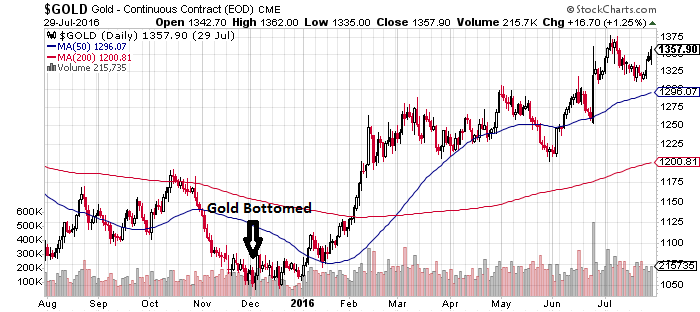
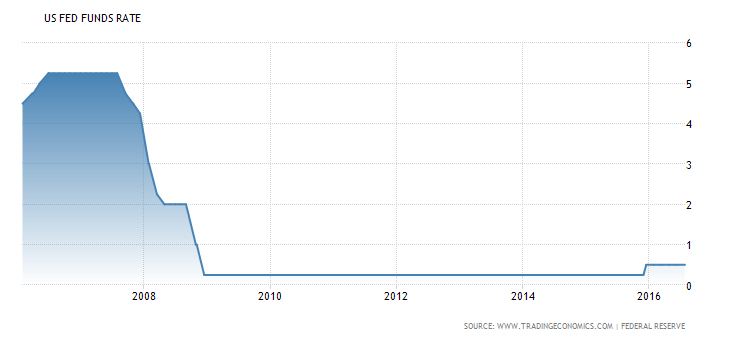
Gold bottomed in December 2015, after a much-anticipated Federal Reserve interest rate hike – the first in 7 years.
Perhaps the market sensed that the Fed has done away with its interest hike campaign?
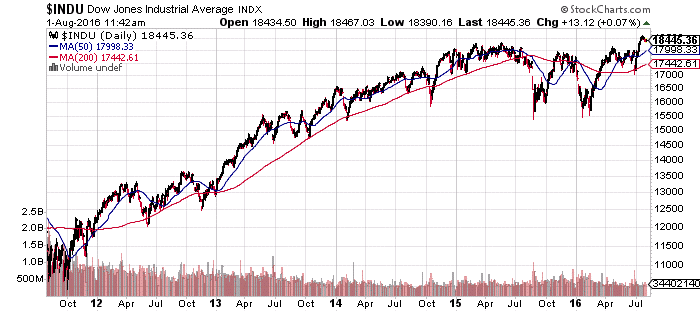
The Dow Jones Industrial Average hit an all-time high in early July – does this chart look like a bear market to you?

The US 30-year bond price also hit an all-time high in July (record low yield) – does this chart look like a bear market to you?
What if Mr. Rosenberg is wrong, and the Fed stops QE and instead embarks on a Volcker-style rate hike campaign similar to the one used when the US Federal Funds rate peaked at 20% in June 1981?
In the unlikely event that the global economy miraculously recovers and the Fed quadruples the Federal Funds rate from the current, miniscule 0.5% to say, a tiny 2% in short order, dividend stocks would crater, and US bond prices would crash with hoards of speculative liquidity and baby-boomer savings looking for a safe haven – not exactly the recipe for a gold bear market.
Either way (hike or no hike), there is no place for the gold bull to hide. It took gold approximately 7 months to advance $250 and overcome major resistance at $1,300/oz from a bottom of $1,050. A reasonable target could be $1,550/oz ($1,300 + $250) by March 2017 – 7 months from now. Silver could follow a similar pattern with a near-term target of $26/oz.
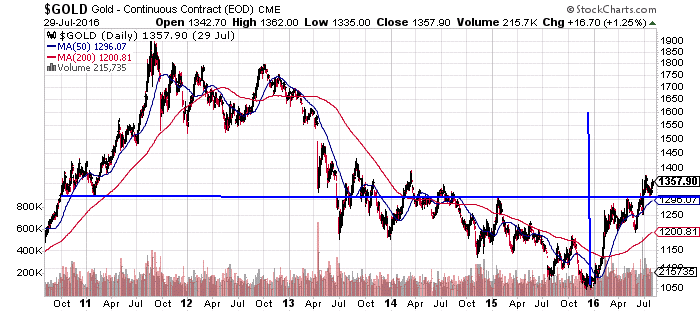
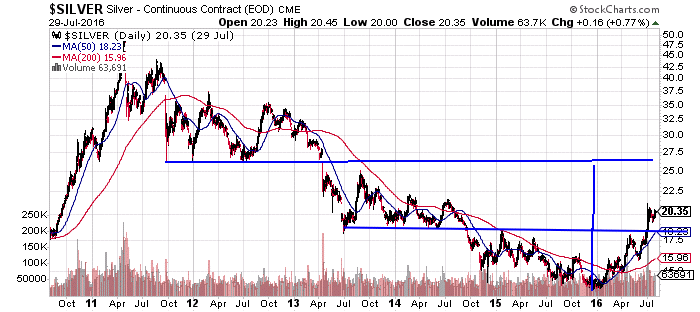
I own physical silver and manage a company engaged in silver exploration.
John Lee, CFA
Executive Chairman, Prophecy Development Corp.
John Lee, CFA is an accredited investor with over 2 decades of investing experience in metals and mining equities. Mr. Lee joined Prophecy Development Corp (www.prophecydev.com) in 2009 as the Company's Chairman. Under John Lee's leadership, Prophecy raised over $100 million through Toronto Stock Exchange and acquired a portfolio of silver assets in Bolivia, coal assets in Mongolia, and a Titanium project in Canada. John Lee is a Rice University graduate with degrees in economics and engineering.
About Prophecy Development Corp.
Prophecy Development Corp. is a Toronto Stock Exchange-listed (TSX: PCY) Canadian company focusing on mining and energy projects in Mongolia, Bolivia and Canada. Further information on Prophecy can be found at www.prophecydev.com.
© 2005-2022 http://www.MarketOracle.co.uk - The Market Oracle is a FREE Daily Financial Markets Analysis & Forecasting online publication.



